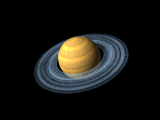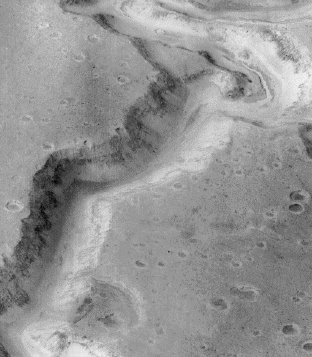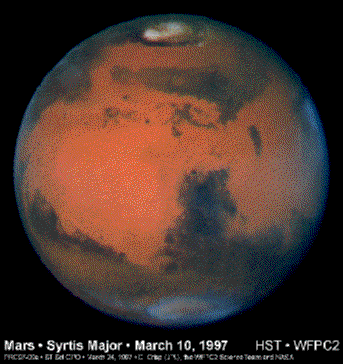



 The Astronomical Picture of the Day
The Astronomical Picture of the Day Today @ NASA
Today @ NASA Today's Sci-Tech
and Space
news from CNN
Today's Sci-Tech
and Space
news from CNN  Astronomy and
Space
news from Space.com
Astronomy and
Space
news from Space.com Sky & Telescope Weekly News Bulletin
Sky & Telescope Weekly News Bulletin HST Press Releases
HST Press Releases Chandra Press Releases
Chandra Press Releases NRAO News & Events
NRAO News & EventsI have not updated the news here since summer 2001, and due to the lack of interest, I will not be updating this site further. If anyone would particularly like to have me keep this site running, let me know.
April 30, 2001 - New measurements of the power spectrum of fluctuations in the CMB still show remarkable agreement with predicictions of the inflationary hot big-bang model. The DASI experiment is the new kid on the block, while the BOOMERANG and MAXIMA ballon missions also reported on refinements of their datasets. See the CNN story.
April 24, 2001 - The Hubble Space Telescope celebrates its 11th anniversary with a present - an amazing image of the Horsehead Nebula in Orion! See the HST press release.
April 5, 2001 - 11 new extrasolar planets were added to the roster, now totaling 63. See the CNN story.
April 2, 2001 - The most distant supernova was spied by Hubble at redshift z=1.7. The brightness of this supernova lends credence to the theory that the dynamics of the Universe is currently dominated by "dark energy" that is causing the Hubble expansion to accelerate. See the HST press release.
March 19, 2001 - The European Southern Observatory reports "First Fringes" for their Very Large Telescope Interferometer.
March 13, 2001 - myriad Xray sources seen in Chandra Deep Fields, indicating Univserse teeming with black holes. See the CNN story.
March 7, 2001 - The Chandra Xray Satellite sees diffuse gas in a group of galaxies, bridging the gap in our knowledge between single galaxies and large clusters. See the CNN story.
February 26, 2001 - A dust torus is seen around young star using the Keck telescope with an interferometer aperture mask. See the CNN story.
February 12, 2001 - The NEAR-Shoemaker spacecraft successfully lands on Eros! See the CNN new story.
February 12, 2001 - The NEAR-Shoemaker spacecraft prepares for a historic crash-landing on the asteroid Eros. See the CNN new story.
February 8, 2001 - Visit the Hubble Space Telescope online exhibit and science web page.
February 1, 2001 - Stellar seismology looks at an older version of our Sun. See the CNN News Story
February 1, 2001 - Hubble telescopse releases picture of the "Ant Nebula". See HST Press Release and the CNN News Story.
January 31, 2001 - NASA's Mars Global Surveyor near end of successful mission. See the CNN News Story.
January 9, 2001 - From the AAS Meeting: a stupendous collection of quasars in the constellation Leo - is this the Universe's largest structure? See the CNN News Story
January 9, 2001 - The Chandra Xray Satellite images the Cats Eye Nebula, the last gasp of a dying star. See the CNN News Story
January 9, 2001 - Hubble images a tenuous intergalactic "pipeline" connecting two adjoining galaxies. See the HST Press Release
January 8, 2001 - From the AAS Meeting: possible evidence for remnants of cannibalized satellite galaxies in our own Milky Way. See the CNN News Story
December 14, 2000 - As part of the Cassini Flyby campaign, the Hubble Telescope catches a spectacular image of the Auroral Oval on Jupiter. See the HST Press Release
November 9, 2000 - Hubble tracks a wayward pulsar, measuring its velocity at just over 100 km/sec! See the HST Press Release.
See also the News Archive.
Astronomers are now in the midst of planning the projects for the next decade - a Decadal Survey Committee has been convened by the National Academy of Sciences to formulate a prioritized plan, as it has in past decades. New telescopes, instruments, and research programs, and educational initiatives are all part of this ambitious effort. As a guide to the current and proposed astronomical observatories and missions, I have compiled a graphical guide:
Since I have just moved from the University of Pennsylvania to NRAO, I thought I would show you something about my new job!
There is more going on in observational astronomy than just what comes out of the Hubble Space Telescope, the Keck Telescopes, and the VLT. In fact, there is much more to astronomy than can be seen at optical and infrared wavelengths. There are a number of space and ground-based astronomical observatories that are brining back spectacular images and fundamental measurements of the "invisible Universe" outside the visible range of light.

The Very Large Array in Socorro, New Mexico
courtesy AUI/NRAO
The Very Long Baseline Array (VLBA) and the Very Large Array (VLA) (VLA) are two of the premier radio astronomical instruments in the world. Together, they constitute an American "continental telescope" with the ability to image phenomena from nearby active stars to distant quasars on angular scales ranging from degrees (using the VLA at low frequency) to the unprecedented resolution of a milli-arcsecond or better (using the VLBA at high-frequency)! In fact, in conjunction with VLBI stations around the world and the orbiting HALCA VLBI satellite, radio astronomy has realized the goal of a global or even a trans-global observatory! In the year 2000, the VLA and VLBA will be joined by the mammoth Green Bank Telescope (GBT), a fully steerable 100-meter radio telescope now being constructed in West Virginia.
Of course, radio astronomy itself has a diverse range of science goals. My own research touches on a number of these topics, ranging from study of the Cosmic Microwave Background Radiation, the Compton scattering of the CMB from hot gas in clusters of galaxies, the gravitational lensing of distant quasars by intervening galaxies. Other radio astronomical research tackles problems closer to home, such as the origin of planetary systems, the formation of stars and galaxies, and even the search for extraterrestrial life!
Some NRAO related links of interest:

The Orion Nebula with WFPC2 and NICMOS,
courtesy STSCI
NASA's Mars Exploration program took two disastrous hits this year with the (likely) loss of both Global Surveyor and Polar Lander. For more on the Mars program, see
The Mars Global Surveyor (MGS) spacecraft was the last spacecraft sucessfully placed into orbit around Mars. As of 6/10/99, MGS had completed 2829 orbits of Mars (1147 mapping orbits), using aerobraking in the thin outer Martian atmosphere to reduce its orbital period from 45 to 11.6 hours (on 6/26/98) and then to the current orbital period of 1.96 hours! Images come back regularly, so see the MGS Home Page for details.
Some of the most recent science images returned include "dust devil" tracks on the Martian desert floor, the volcano Elysium Mons, and the Candor Chasma. Of course, you can find images of the "Face" on Mars which in better lighting looks nothing like a face.

The Namedi Vallis on Mars from MGS.(NASA/JPL)
MGS was the second mission in NASA's ambitious Mars Exploration Program, after the Mars Pathfinder mission landed the Sojourner rover in Ares Vallis this past summer. Over the next 2 years, MGS will map the surface of the Red Planet in preparation for further missions.

Mars, courtesy STSCI
In addition to the Mars probes, there are a number of other NASA planetary exploration missions that are currently active. Here are some links to the major space science missions:

The vulcanized surface of Io, as seen by
the Galileo orbiter. (Courtesy NASA/JPL)

The cracked icy surface of Europa, from
the Galileo orbiter. (Courtesy NASA/JPL)
I will forego the obligatory list of astronomy-related links, and instead direct you to some of the more useful compilations of links.
smyers@nrao.edu Steven T. Myers